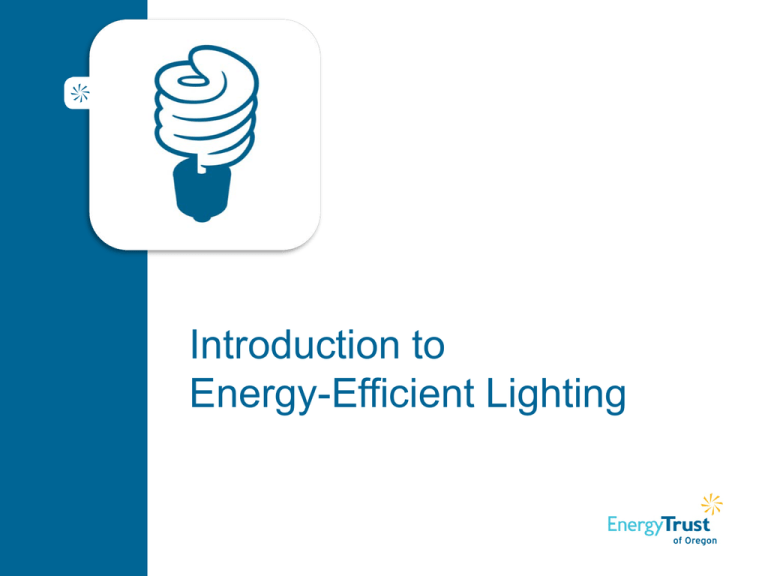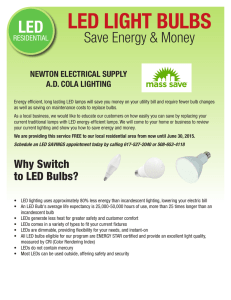Globe bulbs
advertisement

Introduction to Energy-Efficient Lighting What this training includes • Energy-efficient lighting options – CFLs – LEDs • Helping customers shop – Lumens vs. watts – The Lighting Facts label • Energy Trust of Oregon lighting offers Energy-efficient lighting options There are several types of energy-efficient lighting options available in the market, including CFLs, LEDs and halogens. However, they’re not all created equal. Energy Trust recommends that customers purchase ENERGY STAR CFLs and LEDs, as they are thirdparty tested and save money and energy. CFLs Benefits of CFLs Help your customers understand that CFLs: • Provide as much light as an incandescent bulb but use up to 75 percent less energy. • Save up to $30 in electricity costs over the life of the bulb. • Last up to 10 times longer. • Come in a variety of shapes and sizes. Types of CFLs – shapes and styles Spiral bulbs or twists are good for covered lighting fixtures such as table lamps and ceiling fans. A-Lamp bulbs are spiral bulbs with a cover. They are similar to the standard incandescent bulb shape and can be used in a variety of fixtures. Candelabra bulbs are perfect for decorative light fixtures such as chandeliers, wall sconces and covered porch lights. Types of CFLs – shapes and styles Globe bulbs are ideal for fixtures where bulbs are visible, such as bathroom vanities. Indoor reflectors are designed to be used inside in recessed can fixtures. Outdoor reflectors are designed to be used outside and are perfect for flood lights. LEDs What are LEDs? • LED stands for light-emitting diode. This technology is integrated into all sorts of products because of its extreme efficiency. • LED bulbs can last for 25 years, far exceeding other lighting technologies, including incandescent bulbs, halogens and even CFLs. Benefits of LEDs Help your customers understand that LEDs: • Provide an even distribution of light and excellent color quality. • Can be dimmable with the right switch. • Turn on instantly. • Can be used outdoors due to their strong performance in cold environments. Benefits of LEDs • ENERGY STAR qualified LEDs are rated to last at least 25,000 hours, which equals about 25 years of lamp life with standard use. • Provide as much light as an incandescent bulb but can use up to 80 percent less energy. • Can last 35 times longer than incandescent bulbs. • Can provide directional and omnidirectional lighting. Halogens Halogen bulbs Halogen bulbs can be more efficient than incandescent bulbs but are not nearly as efficient as CFLs or LEDs. Halogens: • Are typically 30 percent more efficient than standard incandescent bulbs. • Give off a considerable amount of heat, making them less efficient than CFLs or LEDs, and extremely hot to the touch. • Can be used for directional lighting such as desk lamps. Help Your Customers Shop Choosing the right bulb Guide your customers to consider a few things: • Color and brightness they want. • Type of fixture the bulb will be used in. • Shape and size of the bulb they need. • Cost, durability and energy-efficiency of the bulb. Dimmer compatibility When helping your customers choose the right type of bulb, be sure to ask them if their fixture requires a dimmable CFL or LED, as installing a non-dimmable bulb in a dimmable fixture can cause it to flicker and buzz. Customers may be able to use the same fixture for an LED as with an incandescent bulb, however, dimmers designed for incandescent bulbs may not be compatible with LEDs and they may need to upgrade their fixture for optimal LED performance. Color options • CFLs and LEDs are available in different shades of light (color temperatures), ranging from warm to cool. • Color temperature is measured in kelvin, or K. A lower number indicates a warmer shade of light, while a higher number is cooler and brighter. • It is important to help customers choose the right bulb color for their space. Color Temperature Range for Bulbs Color options – soft white Soft white For a warm, yellow-colored light, similar to traditional incandescent bulbs, choose bulbs marked “soft white” or “warm light.” Soft white bulbs are often used in bedrooms, living and dining rooms. Color options – bright white Bright white/daylight For a cooler, whiter-colored light, choose bulbs marked “daylight” or “bright white.” Whiter light is often used in kitchens or work spaces like offices and garages. The Lighting Facts label • Use the Lighting Facts label to help your customers compare different types of light bulbs. • The label provides information about the life of the bulb, bulb brightness, color temperature and estimated yearly energy costs. Focus on lumens • When shopping for energy-efficient lighting, tell your customers to compare lumens, rather than watts, to compare bulbs. • Lumens measure how much light a bulb produces. More lumens means the bulb gives off more light, fewer lumens means less light. • Watts measure how much energy is being used to power the light bulb. Lumens vs. watts • Incandescent, CFL, halogen and LED bulbs use varying amounts of energy (watts) to produce the same amount of brightness (lumens). • Use the Lighting Facts label to help customers compare lumens and watts for different bulb types. Light Output (Lumens) 450 800 1100 1600 Incandescent Bulbs (Watts) 40 60 75 100 CFL Bulbs (Watts) 11 15 23 26 LED Bulbs (Watts) 9 12 Not currently available Not currently available Energy Trust Lighting Offers Energy Trust lighting offers Reduced priced bulbs • Energy Trust offers a discount of $2 per bulb on specialty CFLs and $10 per bulb on specialty LEDs through Simple Steps, Smart Savings (a collaboration with Bonneville Power Administration). • Qualifying bulbs are already marked down on store shelves, so there is no need for customers to present a coupon to receive the reduced price. Energy Trust lighting offers • The following CFLs and LEDs can be found at reduced prices: CFLs – Candelabra bulbs – Globe bulbs – Indoor and outdoor reflectors – Three-way twists LEDs – Indoor and outdoor reflectors – Recessed can lighting fixtures Contact Energy Trust + If you have questions about the lighting options mentioned in this presentation, contact our program coordinator at 1.877.283.0698, option 2. If your customers want more information about Energy Trust or lighting incentives, have them call 1.866.368.7878 or visit www.energytrust.org/residential/incentives/lighting



